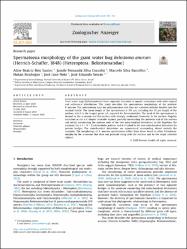Spermatozoa morphology of the giant water bug Belostoma anurum (Herrich-Schäffer, 1848) (Heteroptera: Belostomatidae)

View/
Access
info:eu-repo/semantics/openAccessDate
2020Author
Santos, Aline Beatriz ReisCossolin, Jamile Fernanda Silva
Barcellos, Marcelo Silva
Bozdoğan, Hakan
Lino-Neto, José
Metadata
Show full item recordCitation
Santos, A. B. R., Cossolin, J. F. S., Barcellos, M. S., Bozdoğan, H., Lino-Neto, J., & Serrão, J. E. (2020). Spermatozoa morphology of the giant water bug Belostoma anurum (Herrich-Schäffer, 1848)(Heteroptera: Belostomatidae). Zoologischer Anzeiger, 288, 103-106.Abstract
Giant water bugs (Belostomatidae) have important functions in aquatic ecosystems with wide tropical and subtropical distribution. This study describes the spermatozoa morphology of the predator B. anurum. The spermatozoa have not polymorphism and they are scattered without bundles into the seminal vesicle. The mean length of the spermatozoa is 510 μm, including the 35 μm length of the nucleus, which is the longest germ cell, reported for Belostomatidae. The head of the spermatozoa is formed by the acrosome and the nucleus with strongly condensed chromatin. In the nucleus–flagellar transition occurs a C-shaped centriole adjunct, partially surrounding the posterior end of the nucleus and totally surrounding the anterior ends of the two mitochondrial derivatives. In the flagellum, the axoneme has a 9 + 9 + 2 microtubular pattern, and it is linked to the two mitochondrial derivatives by protein bridges. The mitochondrial derivatives are symmetrical surrounding almost entirely the axoneme. The morphology of B. anurum spermatozoa differs from those found in other Pentatomomorpha by the acrosome that does not protrude along with the nucleus and by the single centriole adjunct. © 2020 Elsevier GmbH
Source
Zoologischer AnzeigerVolume
288Collections
- WoS İndeksli Yayınlar Koleksiyonu [3255]
- Yayın Koleksiyonu [11]

















